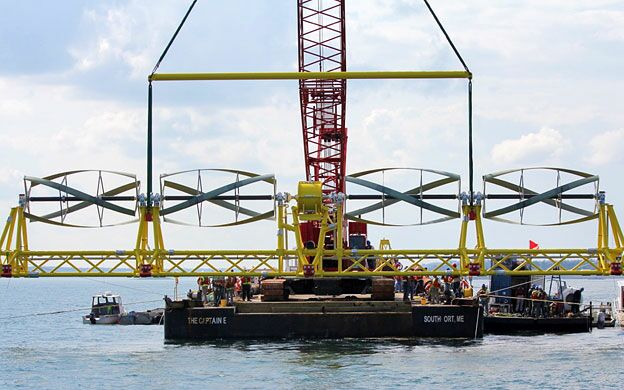Processing Your Payment
Please do not leave this page until complete. This can take a few moments.
- News
-
Editions
View Digital Editions
Biweekly Issues
- Nov. 17, 2025
- November 03, 2025
- October 20, 2025
- October 6, 2025
- September 22, 2025
- September 8, 2025
- + More
Special Editions
- Lists
- Viewpoints
-
Our Events
Event Info
Award Honorees
- Calendar
- Biz Marketplace
River power target of ORPC expansion
 photo/Courtesy ORPC
ORPC's pilot turbine in Cobscook Bay is the basis for new turbines that will expand the company's tidal-power capacity, and for a new turbine modified for river-based power
photo/Courtesy ORPC
ORPC's pilot turbine in Cobscook Bay is the basis for new turbines that will expand the company's tidal-power capacity, and for a new turbine modified for river-based power
The Portland-based Ocean Renewable Power Co. made North American history in September when its 176,000-pound tidal-power generator pumped electricity from Cobscook Bay to a commercial grid for the first time.
Next year, alongside expanding its Maine project into the Bay of Fundy, ORPC plans to make history again by placing a scaled-down version of its pioneering turbine in the Kvichak River, next to the 66-person Alaskan town of Igiugig.
The company received a $1.5 million award for the project earlier this year from the Alaska Energy Authority's Emerging Energy Technology Fund. Scheduled to start next July, the project will be the company's first test of its turbine designed for rivers, which John Ferland, ORPC's vice president of project development, says will open markets worldwide.
"That same market opportunity exists globally, whether North America or Eastern Europe, and it's a matter of getting into the marketplace and showing its viability," Ferland says.
Sean O'Neill, president of the Washington, D.C.-based Ocean Renewable Energy Coalition, says the Cobscook Bay project created a road map for the tidal power industry, which grapples with applying new technology.
"If it didn't exist, [ORPC] created it and that's really quite remarkable," O'Neill says. "It takes the mystery out of tidal power."
Generating electricity through turbines in river water wasn't part of ORPC's initial plan, says Ferland. The focus — both from the generation market and federal regulators — was first on tidal power prompted by a study by the Electric Power Research Institute. Paul Jacobson, ocean energy leader for the EPRI, completed a similar study for the Department of Energy earlier this month, this time focused on river power resources available in the continental United States.
"There's a meaningful resource there that can be captured," Jacobson says.
ORPC estimates that its RivGen system could, someday, provide 10% of the energy needed in rural areas of Alaska, according to its application to the state's energy agency. Nationwide, the company says the technology could contribute to coastal power grids as well as off-grid coastal, island and riverside communities.
More than a toehold
Gathering information has been central to ORPC's development of its turbine systems, including installation methods, maintenance routines and working with a community around a big energy project.
"The real challenge there is that you're putting a project in a semi-permanent deployment where there had not been something like that before," Jacobson says of the Cobscook Bay project. "There are potential conflicts with existing uses and ORPC has done a good job of addressing those."
The biggest breakthrough for the project, Jacobson says, is the 20-year power purchasing agreement the state's Public Utilities Commission approved with Bangor Hydro Electric, Central Maine Power Co. and Maine Public Service that allows the project to expand its capacity up to 5 megawatts, enough to power around 1,200 homes. Under that agreement, power comes in at 21.5 cents per kilowatt-hour for the first year, which is eight cents above the local average and nearly double the state's average price. That, notes Ferland, reflects the emerging technology at its most expensive.
"We're developing a new technology that hasn't existed before," Ferland says. "Our story would be similar no matter what technology we're working with — software or pharmaceuticals or medical devices. Anyone working on product development is on the highest point of the cost scale."
By 2020, the company hopes to bring those costs in line with traditional grid sources — achieving "grid parity" in renewable energy parlance — and Cobscook Bay is now the proving ground for that goal.
Achieving grid parity depends on a wide variety of factors, Jacobson says, but the company's cumulative experience getting projects in the water will help. To start, Jacobson says increasing reliability and reducing required maintenance are top priorities to cut costs alongside an eventual reduction in costs for environmental permitting and licensing that Jacobson says are a result of so little empirical data on how the tidal power installations behave.
"Right now, there's a high barrier of entry and everywhere you go you need two years of environmental data and have to spend a lot of money getting permitted before you have revenue," Ferland says.
The cost of installing all three turbines in Cobscook Bay turbines will be $21 million, including the costs of state and federal permitting, design, manufacture, assembly and installation. That total includes a $10 million U.S. Department of Energy grant. The other two tidal turbines are expected to be installed in 2013.
The company's expansion into the Western Passage into the Bay of Fundy uses a new design to tether and float 24 tidal generator units above the sea floor. That project, completing the 5-megawatt buildout, is estimated at $29 million, bringing ORPC's total estimated costs to $50 million.
Those steep development costs fuel ORPC's strategy, which Ferland says involves some degree of experimentation, observation and interpretation.
"It's a multi-year process of a very staged tech development and a scale of operation that you can work with and then grow from," Ferland says.
The approach allows ORPC some flexibility as it dives deeper into an industry where technologies evolve rapidly and adapt to scale from, say, a tidal turbine to a river turbine. There's a possibility the technology will continue to evolve to the point where individuals with water power access could install their own turbines.
"We're at version one of the technology and we have many more versions to go before [an appliance-scale model] can be done efficiently," Ferland says. "But that doesn't mean it won't happen in the future."
Read more
ORPC files first tidal power report to FERC
Mainebiz web partners

The Giving Guide
The Giving Guide helps nonprofits have the opportunity to showcase and differentiate their organizations so that businesses better understand how they can contribute to a nonprofit’s mission and work.
Learn More
Work for ME
Work for ME is a workforce development tool to help Maine’s employers target Maine’s emerging workforce. Work for ME highlights each industry, its impact on Maine’s economy, the jobs available to entry-level workers, the training and education needed to get a career started.
Learn More
Groundbreaking Maine
Whether you’re a developer, financer, architect, or industry enthusiast, Groundbreaking Maine is crafted to be your go-to source for valuable insights in Maine’s real estate and construction community.
Learn more-
The Giving Guide
The Giving Guide helps nonprofits have the opportunity to showcase and differentiate their organizations so that businesses better understand how they can contribute to a nonprofit’s mission and work.
-
Work for ME
Work for ME is a workforce development tool to help Maine’s employers target Maine’s emerging workforce. Work for ME highlights each industry, its impact on Maine’s economy, the jobs available to entry-level workers, the training and education needed to get a career started.
-
Groundbreaking Maine
Whether you’re a developer, financer, architect, or industry enthusiast, Groundbreaking Maine is crafted to be your go-to source for valuable insights in Maine’s real estate and construction community.
ABOUT
NEW ENGLAND BUSINESS MEDIA SITES
No articles left
Get access now
In order to use this feature, we need some information from you. You can also login or register for a free account.
By clicking submit you are agreeing to our cookie usage and Privacy Policy
Already have an account? Login
Already have an account? Login
Want to create an account? Register
Get access now
In order to use this feature, we need some information from you. You can also login or register for a free account.
By clicking submit you are agreeing to our cookie usage and Privacy Policy
Already have an account? Login
Already have an account? Login
Want to create an account? Register






Comments